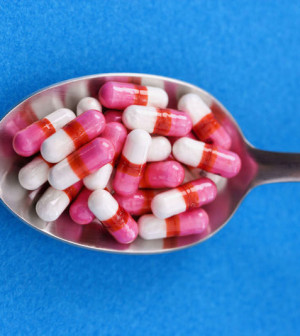- Double Mastectomy May Offer No Survival Benefit to Women With Breast Cancer
- Toxic Lead Found in Cinnamon Product, FDA Says
- Certain Abbott Blood Sugar Monitors May Give Incorrect Readings
- Athletes Can Expect High Ozone, Pollen Counts for Paris Olympics
- Fake Oxycontin Pills Widespread and Potentially Deadly: Report
- Shingles Vaccine Could Lower Dementia Risk
- Your Odds for Accidental Gun Death Rise Greatly in Certain States
- Kids From Poorer Families Less Likely to Survive Cancer
- Tough Workouts Won’t Trigger Cardiac Arrest in Folks With Long QT Syndrome
- At-Home Colon Cancer Test Can Save Lives
Reality TV Star Discusses Addiction Recovery


TUESDAY, Sept. 10At first glance, the story of Michael Paul Sorrentino is a classic rags-to-riches tale: A fitness store employee, exotic dancer and model is struck by Hollywood lightning in his mid-20s, transforming him from a virtual unknown to a reality TV sensation in the flash of a paparazzi bulb.
But as the star of MTV’s mega-hit Jersey Shore says, his fame, fortune and six-pack abs did not insulate him from a problem plaguing so many Americans: addiction to prescription painkillers.
“This disease of addiction has touched not just me but millions of Americans out there,” says the 32-year-old Sorrentino, aka “The Situation.” “Me being in the spotlight, I want to tell my story because there are a lot of misconceptions. I want to let people out there know that there’s hope.”
Although he has discussed some aspects of his struggle with opioid medications before, Sorrentino is now offering a fresh perspective on his experience with detox, and ultimately recovery, in his role as ambassador for the launch of a new awareness campaign — called Reset Reality — taking place during National Recovery Month.
According to the U.S. Substance Abuse and Mental Health Services Administration (SAMHSA), the last decade has seen an estimated 22 million Americans misuse prescription painkillers that were initially legitimately prescribed for themselves or somebody else.
“I think the number of people who are now addicted to prescription drugs, particularly painkillers, is significantly greater than cocaine,” said Jeffrey Parsons, an addiction expert and psychology professor at Hunter College in New York City. “Because access is easier, because it’s legally obtained and because many are under the impression that since it’s prescribed it’s safer and not going to cause the same damage as a hard drug would.”
The bottom-line: In 2009, nearly 425,000 Americans landed in an emergency room for narcotic painkiller abuse, according to the U.S. Food and Drug Administration. And 15,600 of those people died.
Sorrentino said his particular struggle began in 2010, at the pinnacle of his TV career. It was then that he injured his back and neck while appearing in both Jersey Shore and another popular TV show, Dancing with the Stars.
“I was prescribed an opioid from a doctor to help ease the pain,” he said. “I took it for days, for weeks, for months. As the months progressed I became dependent. I needed it just to wake up on a daily basis. But having a prescription from a doctor made me feel it was OK to keep taking it and to get it whenever I needed it. Because I had permission, and I thought the permission granted from a doctor meant that there’s nothing wrong with taking it.
“It was about nine months before I was like, ‘Wow, I’m not the same person anymore,’ ” Sorrentino added. “I don’t work out as much, I don’t love the same things. I wasn’t the same Michael. Finally, it was when I was in Australia on an appearance tour and I couldn’t get the meds and I started to become ill that I realized I needed to get help. I couldn’t do the simplest tasks. I couldn’t get dressed. So I knew this problem was a disease bigger than me, and it needed to be treated as such.”
Sorrentino sought help at a substance abuse clinic in Utah, enrolling in a 12-day detox program, followed by six weeks of medication-assisted rehabilitation.
“Throughout, I was taking Suboxone,” he said. “It really helped me, along with therapy.”
Suboxone is a combination of two narcotic drugs called buprenorphine and naloxone that comes in tablet form. It helps ease the withdrawal symptoms of opiate abuse. Although he has been out of rehab for a year, Sorrentino continues to take the drug on a daily basis.
But that medication is just one option for treating opioid addiction. Methadone is a long-used and effective medication — although it is only available through specialty clinics, while Suboxone can be prescribed by a doctor. Naltrexone is another drug option. All are intended to be used along with behavioral counseling and support.
“I’m not saying that what I took is going to work for everybody else out there,” Sorrentino said. “But that’s what worked for me.”
An addiction expert agreed that there is no single approach that’s right for everyone.
“There are many different drug options available,” said Dr. Adam Bisaga, a professor of psychiatry at Columbia University and an addiction psychiatrist with the New York State Psychiatric Institute in New York City.
“Of course, as always with powerful medications, they can have side effects and be misused,” Bisaga said. Potential side effects of Suboxone include drowsiness, insomnia, stomach pain, and — in extreme cases — breathing problems or allergic reaction.
“But under controlled conditions, which is how [these drugs] are usually given, they can allow these patients to have a much better quality of life,” Bisaga said.
Dr. Adam Rubinstein, an instructor in medicine at Rush Medical College and the University of Chicago’s Pritzker School of Medicine, said it is not unusual to treat a prescription painkiller addiction with another prescription medication.
“A person living with the disease may need medication-assisted treatment to successfully manage his or her condition, similar to other chronic diseases like diabetes and asthma,” Rubinstein said.
Unfortunately, he said, only about 40 percent of adult patients who could benefit are even aware that such drug treatments for addiction are available.
More information
The U.S. National Institute on Drug Abuse has more on treating opiate addiction.
Source: HealthDay
Copyright © 2024 HealthDay. All rights reserved.










